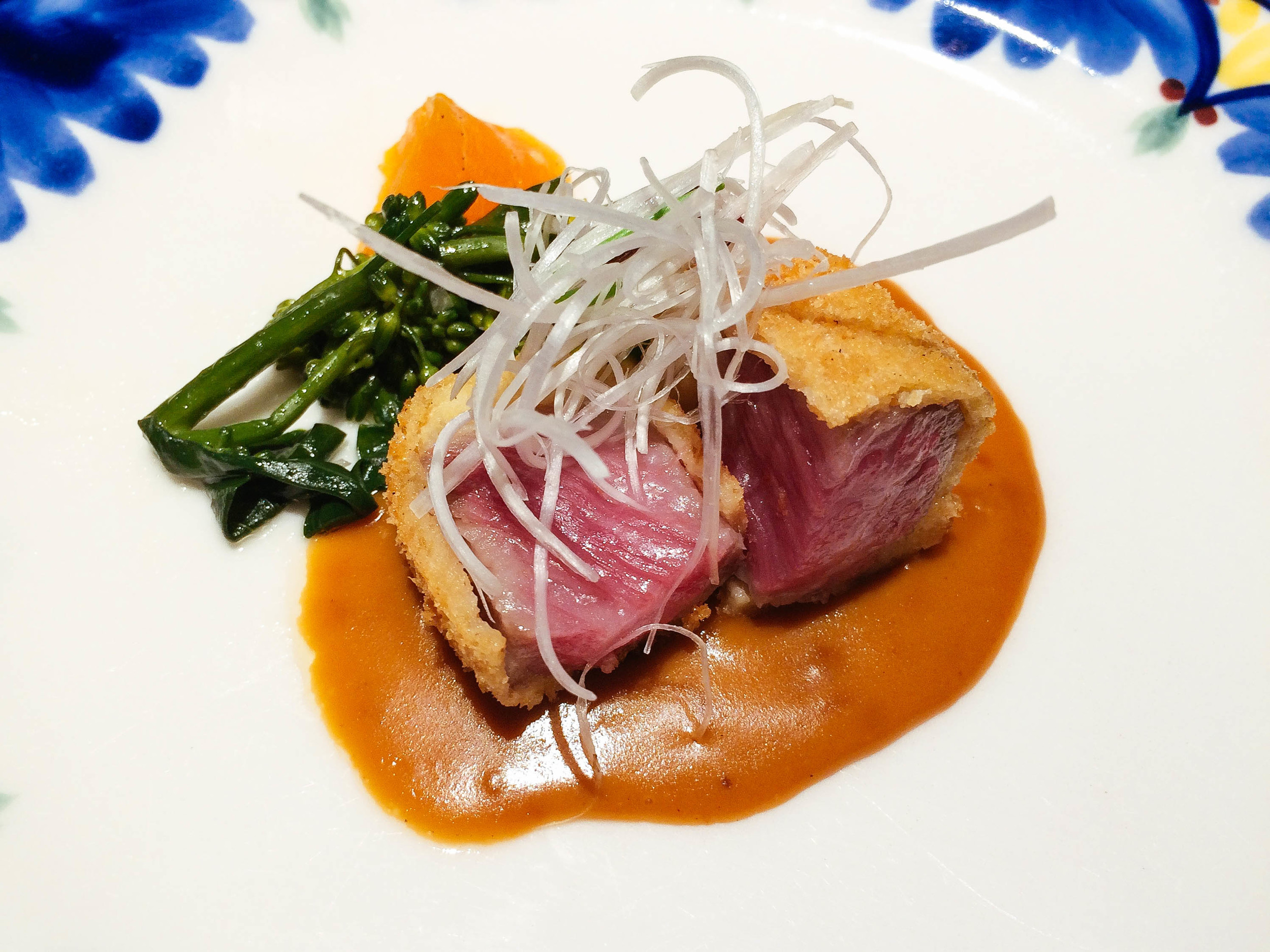“Should we grab dinner here?” I ask my friend as I peer through the glass windows into a bustling counter-style dining area.
“Everything’s in Japanese. What are they even serving?” she replies.
I pick up the sheet of laminated paper hanging near the door and come across Japanese characters. I flip it to the other side, hoping to see something I can understand. A blank sheet of paper stares back at me.
“I have no idea but it’s packed. It has to be good, right?”
We walk in, a little hesitant with the uncertainty to come, but letting our curiosity get the best of us. We’re immediately greeted with a roar of “irrashaimase!” by the chefs behind the counter, the yell quickly easing some of the tension. The small, maybe 15-seater area was already mostly occupied by a sea of men and women in business attire - it was almost seven o’clock after all. Among the boisterous shouts of salarymen well into their second or third glass of cold beer is the subtle popping as battered pieces of vegetables and shrimp are cautiously dipped into sizzling oil.
From my seat, I glance at the chefs in the kitchen, the wooden counter the only barrier between me and their world. Eggplants, carrots and zucchini are stacked high along the back wall, the colorful medley of purple, orange and green a bright contrast to the warm yellow hue of the lights. I’m captivated by the flow of the kitchen, my eyes following the careful preparation of each meal as the chefs move with coordination like runners in a relay. Their faces are full of concentration and their hands move like machines - precise in slicing and meticulous in peeling the towering mounds of shrimp. The most concentrated is the chef in the center, the one standing behind a large vessel of oil, face flushed from the heat. She moves methodically, her chopsticks like extensions of her hands as she retrieves the pieces of tempura from the oil, the occasional splatter causing her to step back. But she’s quick to resume her original position behind the vessel, her concentration never wavering as battered pieces of seafood and vegetables continue to make their way toward her - the skillful care of the chef and her understanding of the oil the final leg of the relay.
She places the perfectly golden pieces on the plate in front of me and smiles. I smile back, wishing I could express my gratitude at the careful creation of my meal, but with my limited Japanese all I could blurt out was, “arrigato gozaimasu!”
I take a moment to appreciate the finished product - tempura, a meal all too familiar back home, had become much more special because unbeknownst to me, on this first night in Osaka, I experienced kappo.
I came to Osaka to eat and rightly so because whereas Tokyo is known for its vast metropolis and Kyoto is known for its serene temples, Osaka is known for its food. Although Osaka boasts a dense number of Michelin-star restaurants, the city’s defining foods come from a more humble origin: street food treats such as takoyaki (pillowy carb-loaded balls stuffed with octopus bits), okonomiyaki (pancakes mixed with an assortment of vegetables, meat and seafood) and kushikatsu (fried skewers of just about anything). As someone in a constant search for dining experiences, whether it be struggling with utensils at a fine dining establishment on a lavish curbside of West Hollywood or squeezing in with the locals under the shady refuge of a hawker centre in Singapore, my top objective in Osaka (other than eating fugu fish and feasting on fresh uni at a seafood market) was to dine at a Michelin-star restaurant.
“Is it possible to get lunch seats for Fujiya 1935?” I asked the concierge after arriving at our hotel in the heart Osaka’s bustling Dotonbori.
“Let me see. What date are you interested in?” she replied in perfect grammatical English with a slight Japanese accent.
“How about Thursday?” I replied.
She slightly chuckled at my bold request to reserve seats at the 3-star Michelin restaurant just two days beforehand, knowing all too well that people usually reserve seats at any 3-star Michelin restaurant months in advance. After probably seeing the slight look of disappointment on my face, Yuna, our hotel concierge, was quick to offer several other choices in the area. Thanks to her and her seemingly eternal patience, I was able to obtain seats at Wayoyuzen Nakamura, a 1-star Michelin kappo-style restaurant. I thought I had conquered the most difficult hurdle, but little did I know about the oncoming curveball to locate Wayoyuzen Nakamura itself.
My friend and I arrived thirty minutes early to the circled location on the map, but after wandering the area for almost twenty minutes, we were admittedly lost. The circled area occupied a space teeming with what seemed like twenty izakayas scattered among alleys and stacked one above the other in multiple buildings. To be short, pinpointing Wayoyuzen Nakamura was like searching for a needle in a haystack - a confusing hiragana, kanji and katakana haystack.
I panicked a little, remembering Yuna’s strict warning that a late arrival would result in a cancellation of the reservation as well as a full meal charge. We had ten minutes until our seven o’clock reservation and after multiple failed attempts at matching Japanese characters on the signs with the one listed on our reservation sheet, we were running out of options. I called the restaurant, knowing the chances of the staff speaking English were slim, but time was ticking and we were stuck in an izakaya abyss. The phone rang several times before someone answered.
“Hi, my name is Jessica and I have a reservation at 7 but we’re lost,” I spoke slowly.
“Ah, gomen nasai. No English. Reservation?” someone replied, obviously confused.
“Um, hai. Reservation for Jessica. I can’t find the place,” I replied again.
No luck. After several attempts, the language barrier seemed to just grow higher. I apologized and ended the call.
I was desperate. I had a few minutes left until seven o’clock. My phone was almost out of battery from the call and my overuse of the navigation map. Alyssa, my friend, was scavenging her bag for an external battery - her phone’s charge life was even less than mine. I threw a Hail Mary attempt and called the hotel concierge front desk, shrugging my shoulder at the oncoming ridiculous international fee charges about to accrue on my bill statement. When a familiar soft voice answered my call, I almost threw my hands up in celebration. It was Yuna. She understood and told me to wait for her phone call back. I ended the call and clutched onto my phone, staring at the black screen, eyes glued to clock.
I got a call back less than a minute later.
“Hi, Jessica? I talked to the chef. He said he’ll send someone to get you both in front of the Korean embassy.”
“Okay thank you! Sorry sorry! Arrigato gozaimasu!” I told her, bowing with my phone by my ear as if I were speaking to her in person.
So there we were, two lost Americans standing in front of the Korean embassy, waiting for a chef from a Michelin-star restaurant to find us. It was safe to say we felt embarrassed standing in front of the steps like schoolchildren waiting to be picked up. A few minutes passed before I spotted a woman in a chef’s hat walking towards our direction. She too, knew little English, but she greeted us enthusiastically with a smile and led the way. We followed her just steps around the corner, down an alley small enough for two people side by side to pass through, into Wayoyuzen Nakamura. Alas, we made it!
///
Wayoyuzen Nakamura, Osaka
1-star Michelin
Although we were unable to sit at the counter to watch the chef execute the dishes, the presentation and flavors of the 13-course meal were more than enough to make me forget about our close encounter with cancellation earlier in the day.
The Japanese are masters of subtlety, relying not on bold aggressive flavors, but on the original essence of each ingredient. The course opened with seaweed salad and a tempura mix of seasonal vegetables, gradually progressing to the heavier dishes - fatty marbled wagyu beef in miso sauce, charcoaled bamboo and curry rice. The dishes expressed the beginning of nature’s bounty, the chef eloquently narrating the story of springtime in Japan through his craft. I conquered my objective in Osaka, while Osaka, through its chefs working behind the wooden counters, the takoyaki food carts and the flat iron okonomiyaki griddles, quietly conquered its own.












